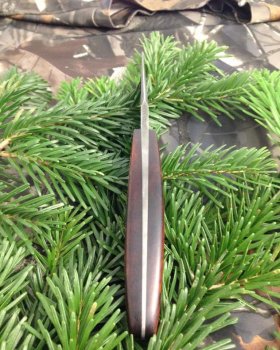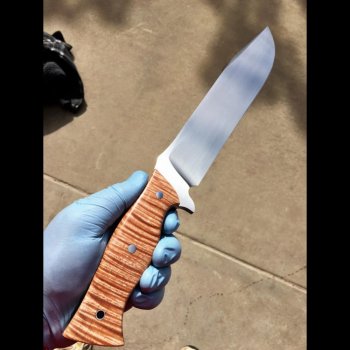So when looking at the projects on my bench the other day I saw I have an untouched bar of 1095 that's 1 1/2 x 1/8 sitting in the corner. I thought it would be fun to make a camp knife out of it. Currently I have only worked on smaller hunter/utility knives. I would ideally like to make this one with a 6-8" blade and ~5" handle. Would this steel thickness work for a project like this or am I setting this blade up for failure in the field?
You are using an out of date browser. It may not display this or other websites correctly.
You should upgrade or use an alternative browser.
You should upgrade or use an alternative browser.
Camp knife thickness?
- Thread starter Daffy
- Start date
John Wilson
Well-Known Member
I can't speak to 1095 because I don't use it.
I made a run of 6inch bladed camp knives from 1/8 CPM154. I would not do it again. For anything up to 4inches, 1/8" is perfect for the kind of knives I make since I prefer slicing performance in my designs. Longer than four inches and 1/8" with a full flat grind becomes flexible. At 6 inches those blades had too much flex for hard use in my opinion. For their intended customer they were fine- those knives were never intended to get beat on or used to split logs.
For anything over four inches I personally think you are in 3/16 territory, and if they are going to be camp choppers I'd go slightly thicker still. You could probably do a 3/4 height grind if you really want to use your 1/8 stock, but that's really a question of blade geometry where you are trading cutting performance for toughness.
I made a run of 6inch bladed camp knives from 1/8 CPM154. I would not do it again. For anything up to 4inches, 1/8" is perfect for the kind of knives I make since I prefer slicing performance in my designs. Longer than four inches and 1/8" with a full flat grind becomes flexible. At 6 inches those blades had too much flex for hard use in my opinion. For their intended customer they were fine- those knives were never intended to get beat on or used to split logs.
For anything over four inches I personally think you are in 3/16 territory, and if they are going to be camp choppers I'd go slightly thicker still. You could probably do a 3/4 height grind if you really want to use your 1/8 stock, but that's really a question of blade geometry where you are trading cutting performance for toughness.
Last edited:
It depends on what you do with your camp knife. Are you splitting logs and hacking down trees? Then it's probably not thick enough. Are you making small traps, prepping food, trimming branches, and slicing up game? It'll probably be just fine as long as the heat treat is good. Personally I use a hatchet, axe, or machete for my chopping and use a thinner bladed 5-6" utility knife for everything else around camp.
-Aaron
-Aaron
making small traps, prepping food, trimming branches, and slicing up game
My intention would be to use it for something closer to this.
rhinoknives
Well-Known Member
1/8" thickness of any cutlery steel will work just fine for these chores.
making small traps, prepping food, trimming branches, and slicing up game
J. Doyle
Dealer - Purveyor
A full flat grind should be fine and I think the 1/8" would be fine too.
I've said it before and I'll say it again here....I think a lot of people would be surprised at how thin some of the big knives of the early days of America were. Without getting too deep into it here, there were plenty of reasons for the trappers, pioneers and frontiersman had thinner blades. But they had axes, hatchets and saws for heavier work. The thinner you can get away with, the better it will slice, which is the primary use of any knife.
I've said it before and I'll say it again here....I think a lot of people would be surprised at how thin some of the big knives of the early days of America were. Without getting too deep into it here, there were plenty of reasons for the trappers, pioneers and frontiersman had thinner blades. But they had axes, hatchets and saws for heavier work. The thinner you can get away with, the better it will slice, which is the primary use of any knife.
samuraistuart
Well-Known Member
Daffy, 1/8" is going to be very very functional, not matter what steel it is. For the life of me, on this thread and the one on BF where 1/8" is "too thin"....I HIGHLY disagree. Strongly disagree. Take a look at how thick a machete is...and tell me 1/8" is too thin for heavy duty work. I personally would not go OVER 1/8", whatever the length and height.
Self Made Knives
Well-Known Member
After a couple of big dogs have weighed in, I should probably keep my mouth shut, but......... I've made my little survival knife in both 1/8" and 5/32". The difference seems small, but I've come up with my own ideas about 1/8". For these knives, if I am going to put a swedge on the spine with a full height flat grind, I don't like 1/8". The tip ends up so thin, I'm scared its going to broken by the user. With a swedge, I also have to be really careful not to lose the temper on the tip when finish grinding. So my rule on the Lancer (my survival design) is 1/8" is fine with no swedge. If I'm grinding a swedge, I feel better if I step it up to 5/32".
That's was something I thought about as well but a machetes grind and length is different so I still had some doubts.For the life of me, on this thread and the one on BF where 1/8" is "too thin"....I HIGHLY disagree. Strongly disagree. Take a look at how thick a machete is...and tell me 1/8" is too thin for heavy duty work.
Coincidentally I carry a small saw and hatchet in my pack. LolI've said it before and I'll say it again here....I think a lot of people would be surprised at how thin some of the big knives of the early days of America were. Without getting too deep into it here, there were plenty of reasons for the trappers, pioneers and frontiersman had thinner blades. But they had axes, hatchets and saws for heavier work. The thinner you can get away with, the better it will slice, which is the primary use of any knife.
I do agree that some knives on the market appear to be over built. Although, personally I'm still trying to learn what thickness, steel and material to use for what build.
That being said I'm also still learning about design do and don't. So if you guys have a moment to critique this initial sketch I'd appreciate it.

rhinoknives
Well-Known Member
^^^ Daffy, I would raise up the bottom of the rear of your handle just a smig so there is less change of bashing/hitting your knuckles when working on a flat surface,
To put it bluntly, Sharpened pry bars have been the rage like fins on the car rear fenders were in the 50's. Look at any of the knives that were used during WWII.
Somehow many were made without 1/4" thick or thicker steel and I don't remember hearing any stories about them breaking in the field or combat by my father's generation. Look at the Pal 36 model. About 1/8 - 5/32" served many well there, Korea Vietnam any many survive to this day.
Daff, Make the knife out of 1/8 or 5/32"?, see if you can break it without beating it with a hammer.
When I started I was taught to test my knives for their given design.
You should do the same. I like your pattern up there. Make one and test it.
To put it bluntly, Sharpened pry bars have been the rage like fins on the car rear fenders were in the 50's. Look at any of the knives that were used during WWII.
Somehow many were made without 1/4" thick or thicker steel and I don't remember hearing any stories about them breaking in the field or combat by my father's generation. Look at the Pal 36 model. About 1/8 - 5/32" served many well there, Korea Vietnam any many survive to this day.
Daff, Make the knife out of 1/8 or 5/32"?, see if you can break it without beating it with a hammer.
When I started I was taught to test my knives for their given design.
You should do the same. I like your pattern up there. Make one and test it.
John Wilson
Well-Known Member
Maybe I got too worried over how flexible the blades got using 1/8". Do you guys find that a flexible blade isn't an issue with a camp knife? As I said, I do slicers and a lot of kitchen knives so I wouldn't ever break a knife using it for its intended purpose. I was under the impression that a camp knife shouldn't be flexible. Frankly, I'm glad to hear that so many of you veteran makers prefer thinner blades.
Matt de Clercq
Well-Known Member
Interesting read. I think 1/8" thick is fine but I prefer .160". The steel you have will be fine. With your design, you may want to make the rear of the handle slightly taller, especially the top. And then when shaping the scales, sand the rear skinnier than the front 2/3. I feel like taller and skinnier in the rear and short and rounder towards the front gives me better control for camp chores. If you are using wood scales, you may want to make sure your pins are not too close to the edge of the handle because they could split the wood.
Attachments
Matt de Clercq
Well-Known Member
Nice. You can always start big and grind it down if your pins aren't in the way and you keep things cool. Looks good!
taylormadeknives
Well-Known Member
I think most use too thick of steel these days. You only need the weight when chopping. I've built a few competition cutters and I learned a lot about edge geometry, slicing abilities, grind and edge thickness. Testing is the only way to figure it out. Go for it and make your own opinion
Sent from my SM-G920P using Tapatalk
Sent from my SM-G920P using Tapatalk
Alaska Man
Member
My initial thought is, what are your handles made of? Will they be a bit light for good balance. Unless your using lead for scales.. ;-) Taller/thicker/longer handle may be required.
My initial thought is, what are your handles made of? Will they be a bit light for good balance. Unless your using lead for scales.. ;-) Taller/thicker/longer handle may be required.
Not sure I understand. For something of this size and desired use I would think you want the weight slightly forward? I also plan on probably using 3/8 micarta for my handles.




